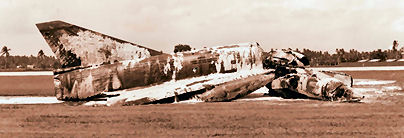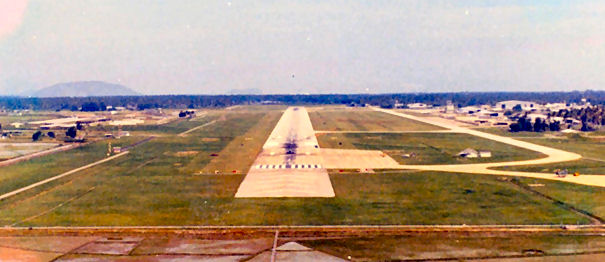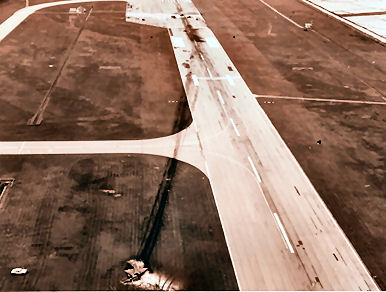|
|
||||||||||||
|
||||||||||||
|
Privacy Policy | Editorial Policy | Profit Policy | Join the Association | List of Members | Contact us | Index | Links |
||||||||||||
|
Back Go to page: 1 2 3 4 5 6 7 8 9 10 11 12 13 14 15 16 17 18 19 20 Forward
|
||||||||||||
|
MIRAGE FATAL ACCIDENT ON BUTTERWORTH RUNWAY 06 July 1976 By Jim Hall I was having a clean out on my computer recently and I came across a couple of photos of the accident at Butterworth when one Mirage landed on another back on 06 July 1976.......40 years ago.
At the time I was a Herc Flight Engineer on C130A’s at 36 Squadron and
we were on a regular Butterworth supply run which on the day meant
Darwin-Tengah (RSAF Fighter Bas
The following is an attempt to inform and perhaps clear up any misconceptions on what happened on that tragic day. There were plenty of rumours and half-truths and as it worked out, these were surprisingly accurate. I asked around and I had a fair knowledge of what may have happened when The Aviation Safety magazine SPOTLIGHT of Feb 2014 (page 18) turned up which carried the full report. This then made my task much easier and more accurate which is paramount.
It appears one Mirage was doing circuits interspersed with ‘touch and
go’s and ‘go-arounds
The Mirage, having a delta wing with no leading edge or trailing edge flaps, had a very high Angle of Attack (Incidence) on landing and pilot forward vision, although good, was not ideal, to the extent there was an indicator in the cockpit reflecting the Angle of Incidence of the aircraft by a series of lights. I understand A3-26 was on another test flight after numerous post E Serving test flights. It was in the process of being transferred from 75 Squadron to 3 Squadron.
I was fortunate to get the following comments and observations from Bruce Grayson, one of our Association members and an ex CO of 3 Squadron at Butterworth (March 1977 - July 1979), so I present them without alteration:
“Aircraft accidents rarely result from a single causal factor and this accident is no exception. There are several factors involved here, any of which, if eliminated, could easily have influenced the result. 1. The pilots were on different radio frequencies - one on tower frequency and the other on GCA (Ground Controlled Approach) frequency. This is a standard, normal, necessary procedure but does mean that one cannot hear the instructions being given to the other. 2. The departing aircraft, because of the ground tests required before takeoff, had entered the runway from the ORP (Operational Readiness Platform) which placed him further down the runway than usual and was positioned within the ‘normal Mirage touchdown zone’, i.e. 500 ft down the runway. 3. The ‘normal touchdown zone’ was contaminated with black rubber deposits - the result of many years of aircraft landings. When combined with the dark Mirage camouflage paint scheme this made any Mirage aircraft within this area very difficult to see from the air, especially by the pilot of a Mirage which has a very high angle of attack at normal approach speeds. Apparently, and as a result of this incident, a regular program of de-rubbering the runway thresholds was introduced and continues to this day.”
The official report from the Spotlight publication is elsewhere in this newsletter and includes an aerial view of a Mirage parked on the ‘rubberised’ section of the runway. Camouflage painting of aircraft obviously works.
Whatever the reasons for this most tragic accident, it reminds us of the inherently dangerous pastime of flying aircraft, more so when they are in the high performance category as was the Mirage. Most aircraft accidents can be tracked back along the ‘chain’ and in hindsight, it becomes obvious that a (‘what if?’) link were to be broken the accident may well have been avoided. This can be as simple as a missing split pin, a ‘say again’ to an indistinct radio transmission or a feeling that something is not quite right. I’m sure all of us have been in a situation where we have thought….what if? Personally, I recall our Herc being given a line up clearance at Townsville one clear sunny day when a B737 was on short finals…….the silence from the tower when we said “is that after the Boeing?” was deafening. A good lesson for all concerned.
I have added some other photos of the wreckage of the aircraft involved which have come across my desk, courtesy of another one of our members……Barry Roberts.
|
||||||||||||
|
||||||||||||
|
|
||||||||||||
|
A3-26 |
||||||||||||
|
|
||||||||||||
|
Official Report.
Mirage Tragedy
By Paul Cross. Deputy Director Safety Communications (DDAAFS)
About 2pm on 6 July 1976, Mirage A3-64 was landing from a practice ground control approach (GCA) and impacted Mirage aircraft A3-26 which was lined-up on runway 18, waiting for take-off clearance.
A3-26 was destroyed and its pilot killed instantly. A3-64 was also destroyed but the pilot escaped without significant injury.
Both aircraft were engulfed in flames almost immediately after impact.
As the aircraft
The pilot of A3-26 was a Category B fighter pilot with a total of 1187.4 hours including 761.5 on Mirage and an authorised squadron test pilot. The pilot of A3-64 was a Category C fighter pilot and considered most dependable, conservative in his approach to flying and well aware of his capabilities and limitations.
Following the investigation, the Court of Inquiry outlined several factors that were integral to the tragic events of 6 July.
Three days before the accident the pilot of A3-64 had returned from a 54 day holiday in Europe. He would have, in that time, established a sleeping pattern consistent with the northern hemisphere summer and, having travelled east to return to Butterworth would have experienced a time shift of more than seven-and-a-half hours. His sleep pattern on return showed evidence of significant disruption consistent with interference to the normal circadian rhythm. The Court noted “One response to circadian dysrhythmia relates to the tendency for mental blocking or lapses in attention. This phenomenon, termed response blocking, has been under investigation in the analysis of accidents, where subjects have apparently failed to see, interpret or react to apparent or dangerous situations”.
Other physiological factors Other physiological factors could also have influenced the pilot’s performance level including his loss of heat acclimatisation and sleep deficit. It was accepted that there would have been a loss of acclimatisation after 54 days in a temperate climate and that it was very unlikely that the pilot had reacclimatised in the three days before the accident. “Two lengthy sorties and a low fluid intake (one cup of black tea and a drink of water) would lead to a body-fluid deficit. The effect of this deficit and loss of acclimatisation would be to increase the individual’s susceptibility to the effects of heat with the resultant fatigue.”
On the two nights before the accident, the pilot had only slept a total of nine-and-a-half hours.
“Sleep deficiency will result in fatigue… fatigue produces a further decrease in performance in an individual subjected to time zone shift.”
|
||||||||||||
|
|
||||||||||||
|
|
||||||||||||
|
Currency.
Following a lengthy break, the pilot of A3-64 was considered “a little
rusty” by his supervisor in a simulator refresher before flying. His
flying of the GCA that culminated in the
GCA four-mile call.
The pilot of A3-64 at the four-mile point was given an instruction by
ATC to check wheels and to overshoot at minimas. This call was given
amid glideslope and heading information and was acknowledged by the
pilot. However, he did not obey the overshoot instruction and was
confident in his own mind that after GCA minimas he had been given
clearance to land. “An important point in regard to the four-mile call
is the fact that there was no laid down requirement to read back the key
executive word of such a clearance.” “In this particular
“The Court therefore believes that had overshoot been read back, there is a high probability that the causation chain would have been broken.”
Hand off at minimas. The hand-off call given to A3-64 by the controller was “continue visually and call the tower on the go.” In contrast, the standard call, as contained in the manual was “look ahead and land/overshoot visually.” The hand-off call was non-standard and importantly did not contain the essential executive word overshoot. This was not a positive and reinforcing four-mile call and contained the ambiguous phrase “on the go”. Some pilots interviewed contended that ”on the go” was consistent with the continuation of a touch and go but all, including the pilot of A3-64 stated they would not interpret the phrase as a change of clearance but would respond to the previous instruction to overshoot and at the least query their clearance.
Departure and arrival procedures.
It was accepted and common practice at Butterworth to line up aircraft with other aircraft on finals. Some controllers would not have done this with an approaching Mirage within three miles of touchdown but at the time of this accident no distances were laid down for visual meteorological conditions (VMC) operations. In this particular instance controllers thought the approaching aircraft was beyond four miles—when in fact it was about three.
Had A3-26 been positioned at the runway threshold, there was a possibility that A3-64 might have cleared it but A3-26 was some 500 feet further along the runway, close to the touchdown point for a ground-controlled approach. This would create a visual problem for the approaching pilot.
A failure to see. The pilot of A3-64 did not perceive A3-26 lining up 500 feet from the threshold of runway 18 and there were a number of factors that could account for this. A camouflage-painted aircraft sitting on the rubber-darkened section in the centre of the runway is not so easy to see. It has a very low contrast ratio and added to this would be the hot gasses emitting from the engine, reducing sharpness of the aircraft’s outline. A3-26 was stationary, reducing the approaching pilot’s visual cues that he was on a collision course.
The position of the sun made it unlikely that any glint from the Mirage’s canopy would be seen by the approaching aircraft.
|
||||||||||||
|
|
||||||||||||
|
Investigation image one mile GCA Finals with Mirage lined up.
|
||||||||||||
|
“During a simulation it was apparent that the target aircraft became invisible when displaced one to two degrees from the central vision. Thus, unless A3-26 had been fixated centrally, the probability of target detection and recognition would have been very small. “Although many pilots are unaware of reflections in aircraft windscreens, this does not alter the fact that they impose an additional load on the visual system and reduce contrast ratios of targets seen through these reflections, thereby reducing the probability of successfully detecting a low-contrast visual stimulus.”
Another factor is that the pilot of A3-64 did not expect to see an aircraft lined up on runway 18 if he thought he was cleared to land. Further, he did not expect an aircraft to be lined up 500 feet from the threshold, where A3-26 was located.
“These factors will affect both the pilot’s visual search strategy and also the perception formed by the brain in response to a particular visual stimuli. The probability of perceiving an aircraft on the runway is likely to be less in these circumstances for a just perceptible stimulus.” A3-26 represented a visual target with a low probability of detection. The effects of fatigue and circadian dysrhythmia may have aggravated the situation by raising visual thresholds, particularly in the periphery, where high workload situations can lead to tunnelling of vision.
The Court concluded that while A3-26 was seeable, the possibility of it being seen by the pilot of A3-64 was remote.
Trainee controller. At the time of the accident, a trainee controller from the RMAF was under supervision and working in the Tower 1 position. From the time the pilot of A3-26 called “ready”, there was a delay of one minute before he was given a line-up clearance. Although there was other traffic in the pattern, there were opportunities to line up A3-26 and obtain a departure clearance from approach. After clearance from the approach controller was given, there was further delay and discussion about the possibility of an airborne confliction between A3-26 and A3-64 and the decision was made to await the overshoot by A3-64 before clearing A3-26 for departure.
“As the controllers had witnessed previous low overshoots, it was only three or four seconds before impact that they realised that A3-64 was continuing with the landing. At this point a controller called ‘overshoot’ into the microphone while another was attempting to select all frequencies.”
By this stage the accident was inevitable. While the delay in clearance of A3-26 was a link in the causal chain, under the circumstances no criticism of the controllers was intended or warranted.
Court conclusions. The primary cause of the accident was that the pilot of A3-64 landed without clearance but that landing was the effect of numerous causal factors that coalesced into a series of events, any of which by themselves would have been insignificant but in this instance came together at one place and at one time for tragic consequences. This complex chain of events could have been broken at many points by the removal of just one of those insignificant events.
DDAAFS comments. The use of non-standard radio calls by both aircrew and ATC continue to be contributory in some Defence aviation safety occurrences with luck often playing a large part in averting disaster. If nonstandard radio calls are detected, it behoves the receiver to question and clarify the call to ensure that there is no miscommunication and both parties understand what is meant or expected.
This accident as usual had numerous contributing factors and failed or absent defences that culminated in tragedy when the pilot mistakenly landed without clearance. Could the accident causation chain have been broken had the other aircraft back-tracked and lined up at the threshold rather than the usual practice of simply taxiing out of the ORP and lining up, or if the upper surface of the Mirage been fitted with an anti-collision light, or the pilot on approach realised and questioned the non-standard radio call?
Physiological and psychological factors were also contributory. Such factors can compromise the safety of a flight by increasing susceptibility to errors and degrading decision making and flying abilities. Pilots are encouraged to use the IMSAFE checklist which is designed to help pilots check whether any of these factors individually, or in combination, affect their physical and mental state before each flight.
IMSAFE Checklist. Before each flight, ask yourself the following questions:
This article appeared in the February 2014 Issue of The Aviation Safety Magazine Spotlight.
Caribou A4-228’s last sortie.
Warbirds Online participated in the dismantling and relocation of RAAF Caribou A4-228 with the Australian Aviation Heritage Centre (QLD) Inc. along with other willing volunteers. It was a big day moving all the relevant equipment from Oakey to Caboolture with everything going smoothly, a testament to the extensive planning undertaken to dismantle, transport and relocate the Caribou aircraft to the hangar at Caboolture. The aim was for the Caribou to join DAP Beaufort A9-141 and the other historic aircraft at Caboolture by the end of June 2016.
(A4-228 was delivered to the RAAF on June 1965 and served with 38 Sqn. In 2009 it was placed in long term storage at Oakey.)
The Australian Aviation Heritage Centre – QLD (AAHC) team commenced work in earnest on DHC 4 Caribou A4-228. The process involved the removal of the many panels and fittings to facilitate the removal of the wings and tail. Defence staff supervised these activities and the relationships between them and AAHC was very positive. The dismantling involved some large machinery and impressive skills being applied, for instance, to remove the wing inner leading edges there are a “million” hidden 3/8th bolts? Some people reckon they breed in there!
|
||||||||||||
|
|
||||||||||||
|
|
||||||||||||
|
The removal of the Caribous from Oakey to various museums across Australia was the largest successful disposal and dismantling project of historic military aircraft in Australia and is a blueprint for the future. It was in everybody’s interest that they succeeded for the ongoing disposal of future retired Australian Military aircraft.
On Day one all the wing bolts and associated connections were dealt with ready for the time when the wings would be separated for transport. The plan was to remove the tail assembly first and then separate the wings. A crane was required for that task.
The inner wing leading edges were removed to give further access to the wing attachments which was a difficult and time consuming task as there are a myriad of hidden hoses and bolts that have to be dealt with requiring the skills of a contortionist. After the tail was removed it was necessary to tilt the fuselage up at the front so they could reach the rear fuselage joint which has to be de riveted for transport reasons as the fuselage would be too high otherwise.
|
||||||||||||
|
|
||||||||||||
|
|
||||||||||||
|
The oil tanks had to be removed so the aircraft would meet its width requirements on its road trip.
Unfortunately, the rain delayed the first large scale dismantling of the
tail and wing assemblies as the crane would be unsafe on the soft
ground. AAHC removed all the
This pic is for you Don!
With the wings removed, the main body of the aircraft was loaded onto a truck for removal to its new home as were the propellers, engines, rear fuselage, wings, tail moveable surfaces and tail cone and a host of small fittings and engine component and other bits and pieces. Kline Transport was the transport of choice. All of the dismantling was done with a view to totally functionally reassembly and no parts were damaged or cut in the process. All of the smaller components and the dismantling equipment were loaded into the fuselage of the aircraft, whilst the fin and rudder as well as the group’s tools were loaded onto the workshop trailer.
Weather and transport permit issues resulted in a week’s delay in transporting the major components of A4-228 from Oakey to Caboolture. The fuselage centre section was on one truck and the wings on a second, both vehicles requiring full oversize transport permits and escorts. The tail surfaces, engines and other remaining components were transported on a variety of AAHC Qld vehicles.
|
||||||||||||
|
|
||||||||||||
|
|
||||||||||||
|
The vehicles left Oakey Museum paddock at approx 5:30PM on Thursday 23 June led by the Police escort vehicles and the Pilot vehicles and headed towards Warwick and then over to Cunningham’s Gap on the Cunningham Highway. They rested at Aratula until 11PM when the permit allowed the journey via the Ipswich Motorway and Gateway Motorway to the Bruce Highway and onto Caboolture, arriving at 3.20am on Friday 24 June 2016. The convoy passed over the Gateway Bridge which was quite a sight with the move covered by the Brisbane TV stations. The convoy numbered 20 vehicles in total and although the weather was not kind and they were to experience rain throughout most of the journey, fortunately it was not heavy enough to cause a delay.
Now that the aircraft has reached its new home, the serious work of reassembly and restoration of it could begin. Whilst the aircraft was largely complete and undamaged a few small items were missing such as, a right hand side windscreen, both pilots seat inertia reels, altitude setting switch, prop control unit and 2 prop oil control units and some minor radio equipment. AAHC approached several sources and hopes to gain access to the items soon. One thing that the group are appealing for are volunteers to work on the Caribou. The aircraft will require a detailed assessment, plan of assembly and many hours of detailed work to restore to display condition and will require many hands to work on her.
All help is gratefully accepted and it’s a good chance to make friends and acquire new skills. No previous experience is necessary. It took 1500 hours to dismantle this Caribou and will easily consume double that to get her restored again. You can work as many or as few days as you choose.
Contact Australian Aviation Heritage Centre – QLD via Facebook or email cessna170@bigpond.com to indicate your interest.
(While removing A4-228 from Oakey to Caboolture is quite a feat, it hardly compares to the restoration job undertaken by the blokes from 35Sqn who, in 1966, replaced the wing, engine, propeller and nose wheel assembly on Caribou A4-173 which had a bad landing at Ba To in Vietnam. Under the threat of enemy fire and in the mud and the rain, with rudimentary tools and using such support equipment as 44 gal drums, sand bags and logs of wood, they carried out their task in only 10 days and the aircraft was flown out. See HERE – tb)
|
||||||||||||
|
|
||||||||||||
|
|
||||||||||||
|
|
||||||||||||
|
|
||||||||||||
|
|
||||||||||||
|
Back Go to page: 1 2 3 4 5 6 7 8 9 10 11 12 13 14 15 16 17 18 19 20 Forward |
||||||||||||
|
|

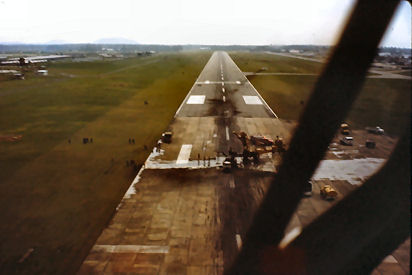 e
in Singapore) - Butterworth. We were taxiing at Tengah for Butterworth
when the runway at Butterworth was declared ‘black’ i.e. closed, so we
taxied back and shut down. Sometime later we were given clearance to
proceed to Butterworth and land over the wreckage which was basically in
the centre of the ideal landing area of the runway (RWY 18). The
remaining available runway was ample for a C130. Here is what I know and
I have attached a couple of pictures (hitherto unpublished) I took as we
landed over the top of the wreckage.
e
in Singapore) - Butterworth. We were taxiing at Tengah for Butterworth
when the runway at Butterworth was declared ‘black’ i.e. closed, so we
taxied back and shut down. Sometime later we were given clearance to
proceed to Butterworth and land over the wreckage which was basically in
the centre of the ideal landing area of the runway (RWY 18). The
remaining available runway was ample for a C130. Here is what I know and
I have attached a couple of pictures (hitherto unpublished) I took as we
landed over the top of the wreckage. 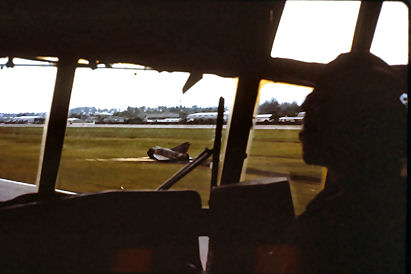 ’
as the pilot had been on leave and he was doing some refresher time.
That was A3-64 (from 75 Squadron), piloted by Flt Lt Paul Kaye and he
was on finals when the pilot of A3-26, Flt Lt Perry Kelly (3 Squadron),
was given clearance by the tower to enter the runway. Subsequently the
one on finals landed on the Mirage on the runway.
’
as the pilot had been on leave and he was doing some refresher time.
That was A3-64 (from 75 Squadron), piloted by Flt Lt Paul Kaye and he
was on finals when the pilot of A3-26, Flt Lt Perry Kelly (3 Squadron),
was given clearance by the tower to enter the runway. Subsequently the
one on finals landed on the Mirage on the runway. 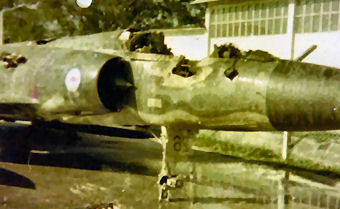
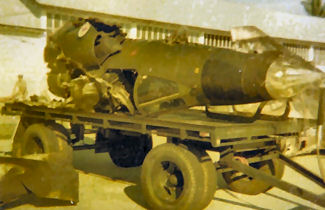
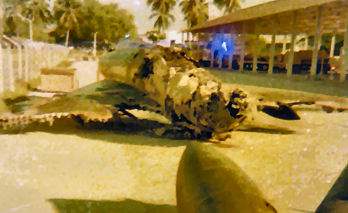
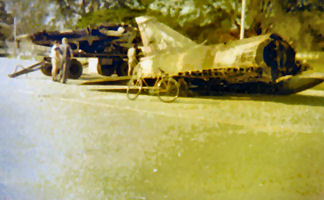
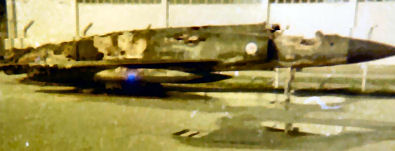
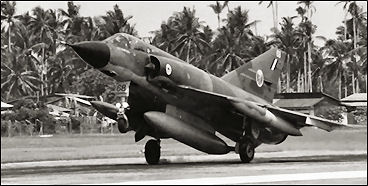 separated, A3-26 continued to burn fiercely as did A3-64 with the
exception of the partially broken away front fuselage section. About
three minutes after impact, the first crash vehicle arrived at A3-64 and
had no difficulty in rapidly extinguishing the fire. Simultaneously,
other crash-rescue vehicles were directed to A3-26 where the fire in the
vicinity of the cockpit area was quickly controlled. However,
considerable difficulty was encountered in containing and extinguishing
the fuselage fire because of fuel leakage and numerous flashback fires.
The ambulance arrived after about seven minutes and the duty medical
officer declared the pilot deceased.
separated, A3-26 continued to burn fiercely as did A3-64 with the
exception of the partially broken away front fuselage section. About
three minutes after impact, the first crash vehicle arrived at A3-64 and
had no difficulty in rapidly extinguishing the fire. Simultaneously,
other crash-rescue vehicles were directed to A3-26 where the fire in the
vicinity of the cockpit area was quickly controlled. However,
considerable difficulty was encountered in containing and extinguishing
the fuselage fire because of fuel leakage and numerous flashback fires.
The ambulance arrived after about seven minutes and the duty medical
officer declared the pilot deceased. 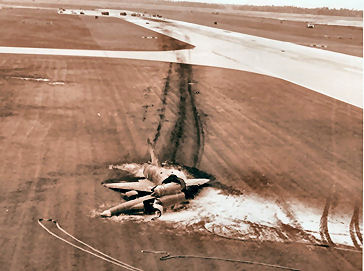
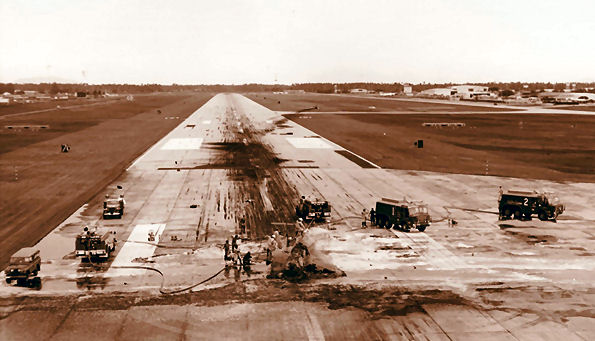
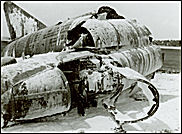 accident was flown very accurately. It was thought that the attention to
accuracy could impose a “greater than usual” workload on top of an
already medium-to-high workload situation. “The pilot was in the habit
of checking his glideslope and centreline at the commencement of the
approach then monitoring his approach on TACAN, which he did. Because of
his lack of currency he only monitored the TACAN range but did not
compare expected height with actual height or monitor approach on the
air-to-ground radar. That is; he was load shedding.”
accident was flown very accurately. It was thought that the attention to
accuracy could impose a “greater than usual” workload on top of an
already medium-to-high workload situation. “The pilot was in the habit
of checking his glideslope and centreline at the commencement of the
approach then monitoring his approach on TACAN, which he did. Because of
his lack of currency he only monitored the TACAN range but did not
compare expected height with actual height or monitor approach on the
air-to-ground radar. That is; he was load shedding.” 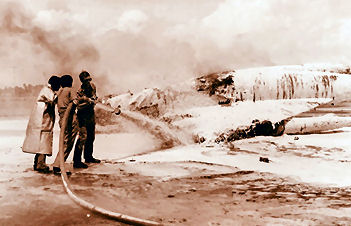 case, read back of the executive ‘overshoot’, firstly, would have
confirmed with the controller that the clearance had been heard and
understood and, secondly would have reinforced the executive in the
pilot’s short term memory, enhancing retrieval or, alternatively,
reducing the probability of substitution.”
case, read back of the executive ‘overshoot’, firstly, would have
confirmed with the controller that the clearance had been heard and
understood and, secondly would have reinforced the executive in the
pilot’s short term memory, enhancing retrieval or, alternatively,
reducing the probability of substitution.” 